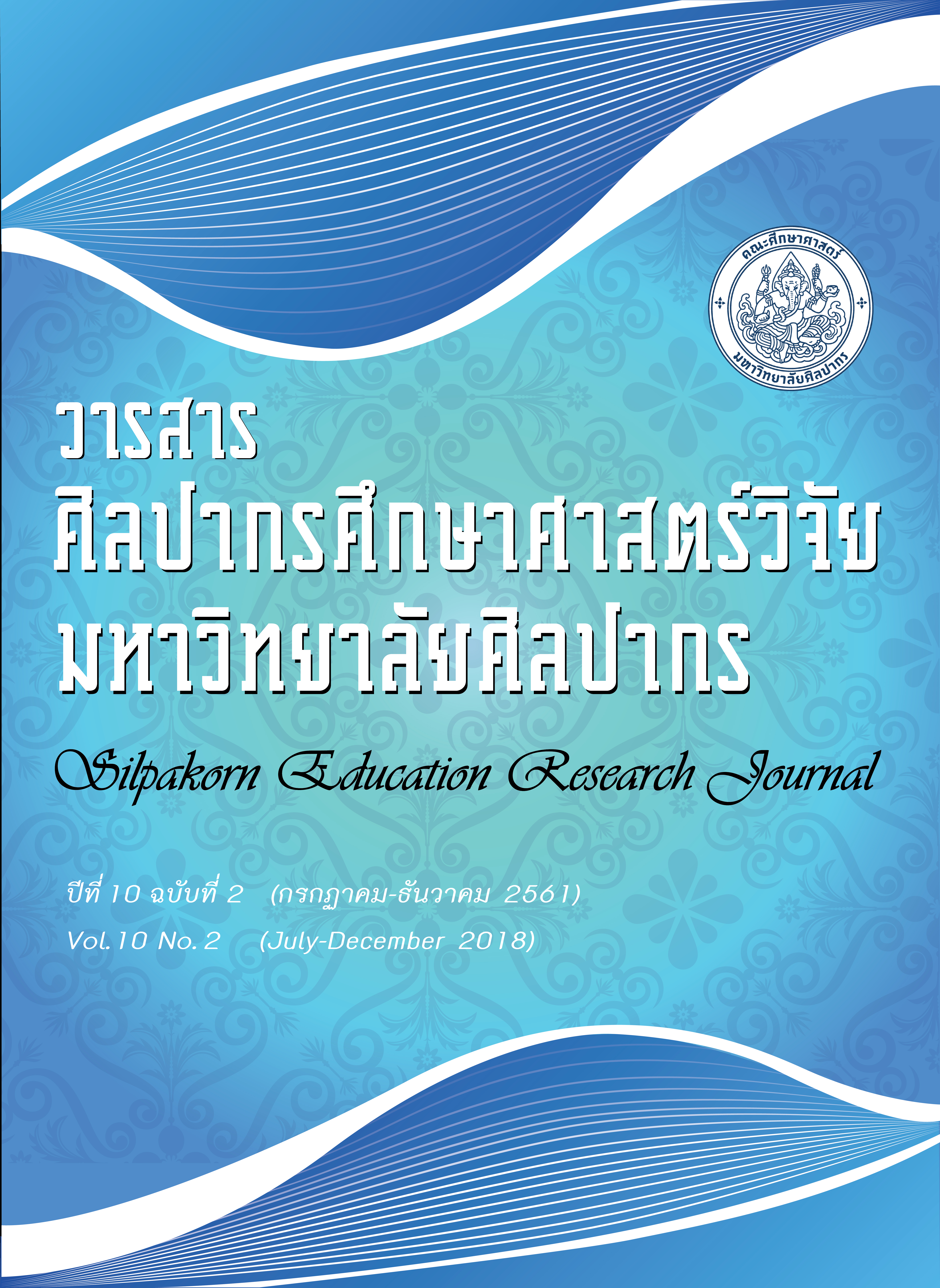การพัฒนาหลักสูตรฝึกอบรมเสริมสร้างความสามารถการจัดการเรียนรู้สำหรับครูภาษาไทยระดับประถมศึกษา เพื่อยกระดับผลสัมฤทธิ์ทางการอ่านและเขียนภาษาไทยของนักเรียนโดยการจัดกิจกรรมการเรียนรู้โดยใช้สมองเป็นฐาน ร่วมกับชุมชนการเรียนรู้ทางวิชาชีพ (The Development of a Training Curriculum to Enhance the Learning Management of Primary Thai Language Teachers to Increase Academic Achievement in Thai Reading and Writing by Using Brain-Based-Learning and Professional Learning Community)
Main Article Content
Abstract
This research is Research and Development. The sample of this study is six Prathom 2-4 Thai language teachers and The study also looks at students that have difficulty reading and writing Thai in Prathom 2-4 during the first semester of academic year 2018 in Tetsabanwatsai Areerak (Maneewittaya) School. The total number of a 35, Data collection tools include: 1) the original curriculum, 2) a test, 3) an evaluation form for learning management, 4) academic tests. The data of this study is analyzed using () (S.D.) and t-test. Results 1) The results of the basic data and needs analysis (R1) found administrators and teachers want a training course so the teachers understand teaching reading and writing Thai language. 2) The results of design and development (D1) of the curriculum design found the suitability of the curriculum design to be (= 4.60, S.D. = 0.43), with a considerable number of respondents classifying it as “highly suitable” (= 4.65, S.D. = 0.47). The highest levels of suitability. 3) The implementation (R2) found Before training, the average was (= 16.50,S.D. = 0.55) and after training was (= 25.17,S.D. = 0.75). The overall learning management ability was (= 4.67, S.D. = 0.42). The assessment of Prathom students was higher after the study. 4) The evaluation and improvement of the curriculum (D2) found that the training course conforms to the needs of the teachers and increase academic achievement in Thai Reading and Writing.
Article Details
References
กรองเทพ เคลือบพณิชกุล. (2542). การใช้ภาษาไทย. กรุงเทพมหานคร: โอเดียนสโตร์.
Kunchumnan Jaree. (2016). “Development of Learning Management Model by Brain-
Based Learning: BBL for Develop reading for understanding Thai language For students in Prathom Suksa 3”. Academic Journal of Mahamakut Buddhist University Roi Et Campus. Vol.5 No.2:228-229.
จารีย์ ขุนสำราญ (2559). “การพัฒนารูปแบบการจัดการเรียนรู้โดยใช้สมองเป็นฐาน (Brain-Based
Learning: BBL) พัฒนาการอ่านเพื่อความเข้าใจ กลุ่มสาระการเรียนรู้ภาษาไทย สำหรับนักเรียนชั้นประถมศึกษาปีที่ 3”. วารสารมหาวิทยาลัยมหามกุฎราชวิทยาลัย วิทยาเขตร้อยเอ็ด.5(2) :228-229.
Buasomboon Busaba,Chanchusakun Saranya,Varasunun Pinda and Nata Natthakit.
“The Synthesis of Teaching Innovations Thai Language Reading and Writing skill of Elementary Teachers”. Silpakorn Education Research Jounal.vol.10 No.1 (January-Jane 2018.)
บุษบา บัวสมบูรณ์ สรัญญา จันทร์ชูสกุล พินดา วราสุนันท์ และณัฐกิตติ์ นาทา.(2561). “การสำรวจ
นวัตกรรมการสอนอ่านและเขียนภาษาไทยของครูในระดับประถมศึกษา”.วารสารศิลปากรศึกษาศาสตร์วิจัย. 10 (1) :28-43.
Thongsoon Peerapun. (2014). The teacher development of cultural tourism
knowledge management program on local wisdom of lower Esan. A Thesis for the Degree Doctor of Philosophy Program in Curriculum and Instruction Department of Curriculum and Instruction Graduate School, Silpakorn University
พีระพรรณ ทองศูนย์. (2556). การพัฒนาหลักสูตรฝึกอบรมเพื่อพัฒนาหลักสูตรการจัดการความรู้
ภูมิปัญญาท้องถิ่นอีสานใต้ ด้านการท่องเที่ยวเชิงวัฒนธรรม. วิทยานิพนธ์ปริญญา
ปรัชญาดุษฎีบัณฑิต สาขาวิชาหลักสูตรและการสอน บัณฑิตวิทยาลัย มหาวิทยาลัย
ศิลปากร.
Thongkorn Putthachat. (2008). “An innovation that solves problems of teaching and
learning Thai”. Academic Journal,11(2):81-86
พุทธชาต ทองกร. (2551). “นวัตกรรมที่ใช้แก้ปัญหาการจัดการเรียนการสอนอ่านภาษาไทย”.
วารสารวิชาการ, 11(2): 81-86.
Poosara Rugee. (2002). The development of curriculum : According to the reform
of education. Bangkok: Bookpoint.
รุจิร์ ภู่สาระ. (2545). การพัฒนาหลักสูตร: ตามแนวปฏิรูปการศึกษา. กรุงเทพมหานคร: บุ๊คพอยท์.
Autthanun Sangat.(1989).Fundamentals and principles of curriculum development.
3rd edition. Bangkok: Department of Educational Administration Faculty of
Education, Chulalongkorn University
สงัด อุทรานันท์. (2532). พื้นฐานและหลักการพัฒนาหลักสูตร. พิมพ์ครั้งที่ 3. กรุงเทพมหานคร:
ภาควิชาบริหารการศึกษา คณะครุศาสตร์ จุฬาลงกรณ์มหาวิทยาลัย
Mahawang Somwang. (2011). The development of a training curriculum to enhance
the teacher of Integration of local wisdom in Basic School Curriculum.
A Thesis for the Degree Doctor of Education Program in Management and
Development Graduate School Maha Sarakham University.
สมหวัง มหาวัง. (2554). การพัฒนาหลักสูตรฝึกอบรมเพื่อเสริมสร้างสมรรถนะครูด้านการ
บูรณาการภูมิปัญญาท้องถิ่นในหลักสูตรสถานศึกษาขั้นพื้นฐาน. วิทยานิพนธ์การศึกษา
ดุษฎีบัณฑิต สาขาวิชาการบริหารและพัฒนาการศึกษา บัณฑิตวิทยาลัย มหาวิทยาลัย
มหาสารคาม.
Poojarathapun Sunee. (2011). The use of Thai for communication. Bangkok:Tripping
Education.
สุนีติ์ ภู่จิรฐาพันธุ์. (2554). การใช้ภาษาไทยเพื่อการสื่อสาร. กรุงเทพมหานคร : ทริปเพิ้ล เอ็ดดูเคชั่น
Waiboonya Sutmon. (2014). The development of curriculum to enhance teacher's
profession al experience to increase communication skills for preschool
children. A Thesis for the Degree Doctor of Philosophy Program in Curriculum and Instruction Department of Curriculum and Instruction Graduate School, Silpakorn University
สุมน ไวยบุญญา. (2557). การพัฒนาหลักสูตรเสริมสมรรถนะการจัดประสบการณ์การเรียนรู้
ของนักศึกษาครูที่ส่งเสริมทักษะการสื่อสารสำหรับเด็กปฐมวัย. วิทยานิพนธ์ปริญญา
ปรัชญาดุษฎีบัณฑิต สาขาวิชาหลักสูตรและการสอน บัณฑิตวิทยาลัย มหาวิทยาลัย
ศิลปากร.
Office of the Basic Education Commission.(2017). Teaching guide of reading and
writing by “Jak-luk-sa-kot-kum”.Bangkok : The Agucultural Co-operative Federation of Thailand Printing.
สำนักงานคณะกรรมการการศึกษาขั้นพื้นฐาน. (2559). คู่มือการสอนอ่านเขียนโดยการแจกลูก
สะกดคำ.กรุงเทพมหานคร : โรงพิมพ์ชุมนุมสหกรณ์การเกษตรแห่งประเทศไทย จำกัด.
Ruksutee Sumree. (2011). Innovative media and plan Innovative media. Nonthaburi :
Poemsup printing.
สำลี รักสุทธี. (2550). การจัดทำสื่อนวัตกรรมและแผนประกอบสื่อนวัตกรรม. นนทบุรี : เพิ่มทรัพย์
การพิมพ์.
Yothasing ,Arunrung and Gumjudpai Sumran. (2017). “Development of a Training
Curriculum Based n the Concept of Blended Learning for Enhancing Primary School Teacher’s Competency of Student-Centered Assessment”. Silpakorn Education Research Jounal.vol.8 No.2 (July-December 2017.)
อรุณรุ่ง โยธสิงห์ และสำราญ กำจัดภัย (2559). การพัฒนาหลักสูตรฝึกอบรมตามแนวคิดการเรียนรู้แบบ
ผสมผสานเพื่อเสริมสร้างสมรรถนะด้านการประเมินที่เน้นผู้เรียนเป็นสำคัญของครูผู้สอน
ระดับประถมศึกษา. วารสารศิลปากรศึกษาศาสตร์วิจัย. 8 (2) : 270-283.
ภาษาต่างประเทศ
Joyce, B, & Weil, M. and Showers, B. (1993). Model of teaching. 4 th ed. Boston : Allyn
and Bacon : A Divison of Simon & Schuster, Inc.
Oliva, P.F. (1992). Developing the Curriculum. 3rd ed. New York: HarperCollins.
Taba, H. (1962). Curriculum Planning: Theory and Practice. New York: Harcourt,
Brace & World.
Tyler, Ralph W. (2003). Basic Principles of Curriculum and Instruction. Chicago:
The University of Chicago Press.
Saylor, J. Galen, and William M. Alexander, and Arthur J. Lewis. (1981). Curriculum
Planning for Better Teaching and Learning. New York: Holt, Rinehart
and Winston

